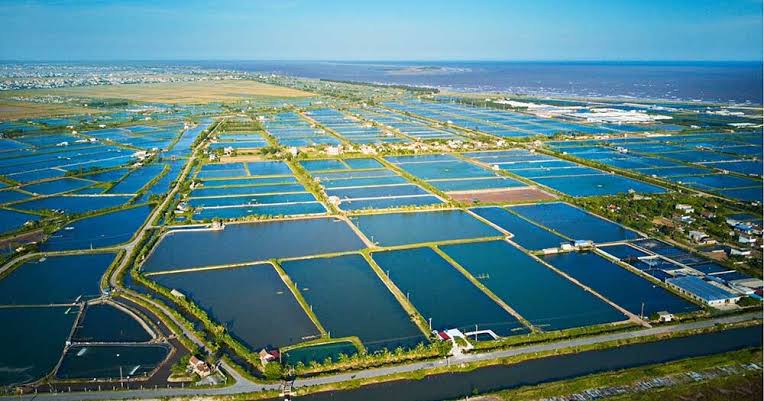Vietnam’s Aquaculture Industry Potential

The Vietnamese government, recognizing the importance of the Mekong Delta for aquaculture, has implemented policies and initiatives to support the industry
Aquaculture, also known as fish farming or aquafarming, is a significant industry in Vietnam due to its long coastline and abundant water resources. With its coastline of 3,260 kilometers and an Economic Exclusion Zone of 1 million square kilometers, Vietnam is an ideal country to boast seafood industry, including both aquaculture and open ocean fishing. The country has a rich tradition of aquaculture and has become one of the world’s leading producers and exporters of aquaculture products.
Vietnam is geographically endowed with ideal conditions for its thriving aquaculture sector.
Accordingly, the sector plays an important role in the country’s economy. Vietnam is ranked as the world’s fourth largest aquaculture producer, behind China, Indonesia, and India.
The Vietnam aquaculture market size reached 4.9 Million Tons in 2022
In 2017, Vietnam produced 3.84 million tonnes of aquaculture products, including 2.69 million tonnes of fish and 723,800 tonnes of shrimp.
Aquaculture accounted for more than 53 percent of Vietnam’s total seafood production of 7.23 million tonnes.
Vietnam’s aquaculture sector primarily focuses on the cultivation of fish, shrimp, and other aquatic organisms. Some of the commonly farmed species include catfish (particularly tra and basa), tilapia, prawns, and various types of shellfish.
Breakup by Region:
Aquaculture systems are diversified according to geographical and climatic conditions:
- Northern Region is dominated by freshwater fish ponds, rice-cum-fish and marine cage culture.
- Central Region concentrates on the intensive culture of giant tiger prawn and the marine cage culture of fin fish or lobster.
- Southern Region has the most diversified farming activities that include pond, fence and cage culture of catfish as well as several indigenous species such as snakehead fish and climbing perch and giant river prawn, various intensification levels of shrimp culture and integrated culture such as rice-cum-fish, rice-cum-prawn and mangrove-cum-aquaculture.
Catfish and Shrimp Farming
Shrimp Farming: Shrimp farming is a prominent sector within Vietnamese aquaculture. The country is known for its production of both black tiger shrimp and whiteleg shrimp (also known as vannamei shrimp). Shrimp farms are often located in coastal areas and utilize both extensive and intensive farming methods.
Catfish Farming: Vietnam is one of the largest producers of catfish globally. Tra catfish (Pangasius hypophthalmus) and basa catfish (Pangasius bocourti) are the main species farmed. Catfish farming is primarily concentrated in the Mekong Delta region, where ponds are used to cultivate the fish.
Aquaculture in Mekong Delta region
The Mekong Delta in the southern part of Vietnam covers 12 percent of the country’s total area and has a high potential for aquaculture development. In fact, the brackish areas comprise 313,000 hectares. The favorable environmental conditions, extensive water surface area, and the abundant fisheries resources make the Mekong Delta the most productive area of brackish and freshwater aquaculture and fisheries in Vietnam.
A certain amount of correlation exists between shrimp farming and the mangrove cover that river deltas possess. While analysis has shown that the decrease in mangrove cover has no impact on shrimp farming, the degree of coverage affects productivity and profit. The optimal coverage is around 60 percent
In fact, nearly three-fourths of the aquaculture production of Vietnam happens here. The Government of Vietnam supports this industry and is targeting it for development by expanding aquaculture in the coastal provinces to a total of 600,000 hectares to produce a total of 600,000 tons of seafood, generating an additional 1.5 billion USD in annual exports.
A great deal of research to has been conducted in the region. A particular feature of fish farming in the Mekong Delta is that it is often practiced in combination with rice production or animal husbandry, and has become an important means for improving the livelihoods of the impoverished farmers.
Another reason for promoting aquaculture here is because eight of the twelve provinces of the delta are flooded for two to six months; and under these conditions, inland aquaculture production is playing an important role.
The aquaculture products from the Mekong Delta, including fish and shrimp, are predominantly produced for export. The region’s proximity to international shipping routes and access to global markets has made it a significant contributor to Vietnam’s aquaculture export industry.
Aquaculture in the Mekong Delta region is a significant contributor to Vietnam’s aquaculture sector. It provides employment opportunities, contributes to export revenues, and helps meet the growing demand for seafood both domestically and internationally. Sustainable practices, proper management, and responsible development are essential to ensure the long-term viability of aquaculture in the region.
The Vietnamese government, recognizing the importance of the Mekong Delta for aquaculture, has implemented policies and initiatives to support the industry. These include promoting sustainable aquaculture practices, providing technical assistance to farmers, and investing in infrastructure development for better water management.


